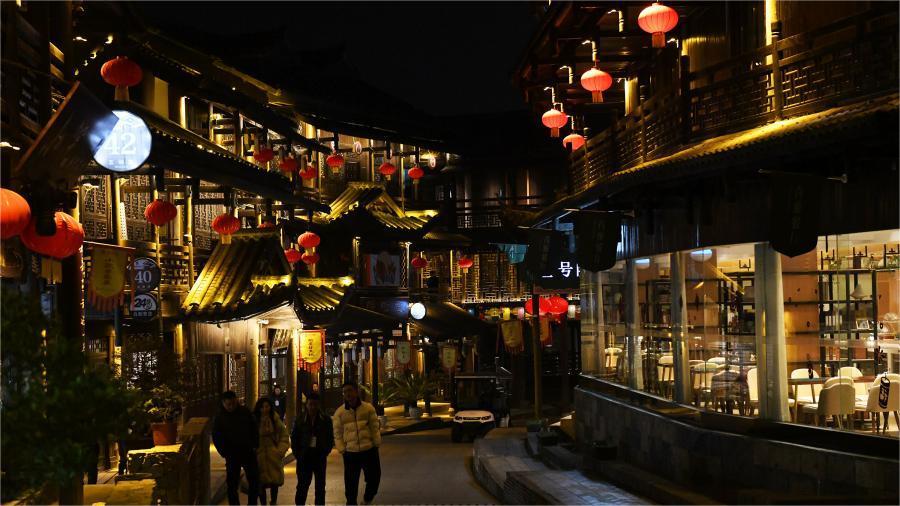Full-fledged sugarcane industry guarantees sweet life for villagers in S China's Guangxi
Making the most of every part of sugarcane plants, Xingbin district, Laibin city, south China's Guangxi Zhuang Autonomous Region, has cultivated a well-developed sugarcane industry and led villagers to prosperity.
Guangxi is the source of two-thirds of China's sugar production. Dubbed "a city that grew out of sugarcane fields,” Laibin city accounts for one-sixth of the sugar output of Guangxi.

Farmers drive agricultural machines to harvest sugarcanes in a sugarcane planting base in Laibin city, south China's Guangxi Zhuang Autonomous Region, Dec. 14, 2023. (Photo/Xinhua)
Half of the sugar from Laibin is produced in Xingbin district, which is known for a sugarcane-based "sweet" industry with an annual output value of over 8 billion yuan ($1.11 billion).
"We send sugarcane to three kinds of 'workshops', namely workshops of the primary, secondary, and tertiary industries. And we continue to seek the high-quality development of the sugarcane industry, fully extracting every drop of value from the sugarcane plants," said Tan Shiyong, an official from the sugar industry development bureau of Xingbin district.
By developing and promoting improved sugarcane varieties, Xingbin district has increased the average yield per mu (667 square meters) of sugarcane fields from about 5 tonnes to around 6 to 7 tonnes, according to Huang Zuming, a villager who is among the first farmers to grow disease-free sugarcane seedlings in Fuyao village, Fenghuang township, Xingbin district.
The proportion of improved sugarcane varieties in the sugar fields has reached nearly 100 percent in Xingbin. Huang said the improved varieties have brought an increase of 1,200 yuan per mu of sugarcane fields to the income of farmers.
Thanks to the extensive application of modern agricultural machinery and fully automated production lines, the output and quality of sugar from Xingbin district have experienced a significant improvement.
Combine harvesters, sugarcane leaf shredders, bundle strapping machines, leaf gathering machines, as well as other agricultural machines, have effectively elevated the production efficiency of local sugarcane growers.
"The entire process of sugar production, from sugarcane delivery to evaporation, has been automated. We can manage the production system with the help of the large screen in the central control room," said Chen Jin, general manager of a sugar producing company based in Fenghuang township.
Sugarcane leaves and bagasse are also maximized in Xingbin district.
"Unlike before, the sugarcane leaves raked from the fields are useful now. The green leaves can be made into feed, the yellow leaves can be used as fuel for power generation, and the rest can be processed into charcoal for daily use," said Wei Bizheng, an official of Liangjiang township, Xingbin district.
Such an effective utilization of sugarcane leaves can help realize a win-win situation for economic development and ecological conservation in the locality, Wei noted.
After undergoing such links as pressing, molding, edge trimming, dust removal, inspection, and packaging, raw bagasse is turned into biodegradable eco-friendly tableware in local workshops.
Firstpak, a molded pulp packaging manufacturer in Laibin city, saw its annual output value reach 400 million yuan in 2023.
The flourishing sugarcane industry has brought great economic benefits to the locals.
Yu Caiku, a major sugarcane grower in Huang'an village, Fenghuang township, is one of the local residents who has benefitted from the "sweet" industry.
After graduating from college in 2015, Yu returned to his hometown to grow sugarcane. While expanding the area of his sugarcane fields, Yu has also established a professional agricultural machinery cooperative, with an annual income of 4.5 million yuan.
"Today, we are living a life as sweet as sugarcane," said Shi Panwen, a major sugarcane grower in Yashan village, Qianjiang township, Xingbin district.
Photos
Related Stories
Copyright © 2024 People's Daily Online. All Rights Reserved.









